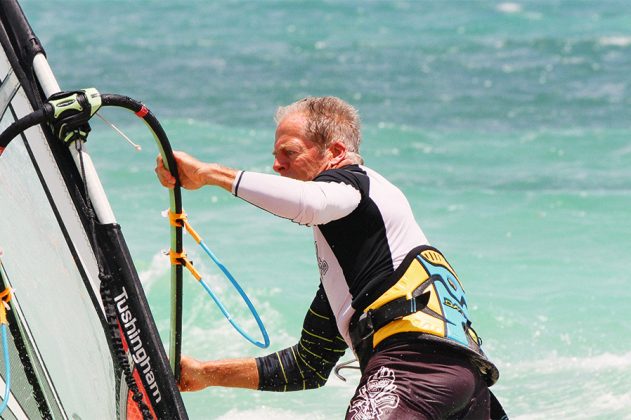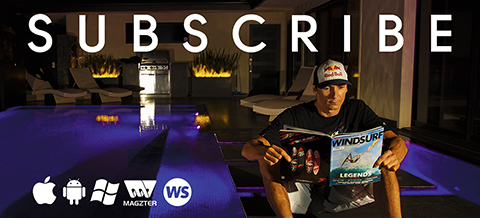CARVE GYBING – THE POWER AND THE GLORY
Words Peter Hart // Photos Hart Photography & Brett Kenny of Radical Sports.
As you seek to master the cornerstone of windsurfing technique, Harty focuses on the issue that most commonly trips up the improver (and that’s all of us) – power control.
Adog is sat on the top of a hill staring forlornly into the middle distance. Underneath the thought bubble reads: “but what if I never find out who’s a good boy?” It was an inspired cartoon described to me by Ken Way, former windsurfer and current performance therapist to Premier League champions Leicester City. (Please see the back page for the full conversation.)
His role is to get players into a mental state where they can perform freely and instinctively – no easy task with the frenetic vocal expectations of 30,000 fans ringing in their ears. I asked if that is where he steps in and says something like: ‘don’t worry son, just go out there and play your own game.’ “In reality”, says Ken, “some are so incapacitated by the situation that like the dog, they’ll say – “but what if I don’t know what my natural game is?’” His task is a good bit more complex and is to provide them with mental and physical coping mechanisms. “They can only perform to the level they’ve trained their unconscious mind”, says Ken. In the case of the elite athlete, at least all the innate skills are there. In windsurfing, when someone is struggling, it’s all too easy to trot out a glib aphorism such as: “relax … go with the flow, feel for that natural balance…” If the basic skills are in place, that may indeed work. But much of the time, they’ll ponder miserably: “but what if I have no idea what ‘naturally balanced’ feels like?” The truth is that to find ‘the zone’ – the mental state where everything is taking care of itself with little to no cognitive input, you need the essential technical tools – and that’s what many are a bit short of.
May the force be … under control
I sit here in Co. Kerry following a proper day’s wave sailing. ‘Proper’ in that wind and waves came from opposing directions to leave a maelstrom of variables designed specifically to confuse and upset the unwary. The slightly offshore wind was blowing down from the mountains gusting up to 25 knots in the rain showers, then down to near enough zero as they passed. The waves, which were clean, well-spaced and decent without being life threatening, accelerated, hid and deflected that wind. The goals of the group were various. The first time wave-sailors were happy just to meet the considerable challenge of getting out through the break and then turning round and landing back within a mile of where they started.
The more advanced were looking to add a bit of zip, speed and slash into their wave-riding and maybe ‘bust a lip’ like they do in the movies. And on the way back home we passed beautiful, sheltered Sandy Bay where local boy Jamie Knox was giving a one on one harness lesson. In all three cases, the protagonists were basically looking to improve the same aspect of their game – their power control.
Getting out through breaking waves – it’s normal windsurfing, except that you’re surrounded by a bunch of those Gladiator types with giant cotton buds all giving you a prod from various directions when you least expect it. Success comes from fast twitch hand control of the sail angle to anticipate surges and lulls, all the time holding a calm body position without over-committing to the rig. Dynamic wave-riding is a power on power off game – powering on to drive the rail, powering off to release the nose and redirect always at exactly the right angle to the wind on the right part of the wave. Power up too soon and you bury the nose and stall; power up too late and you pivot and stop. And back down a level with the intermediate – learning to commit to the harness and release the death handgrip only comes from knowing how to dump power in an instant to avoid the dreaded hooked-in catapult.
Power and the Gybe
Most performance plateaus occur where people’s rig control has lagged behind their ambition. Thanks to wide boards and light rigs, an averagely fit person can be hooked in, strapped up and blasting within six months. It feels like advanced windsurfing – but it isn’t. It’s sitting down and ‘hooning’ with most of the power control being done by the reactive, self-trimming leech. But as they try to change direction, conflicting forces start pinging at them from multiple quarters. As you look to learn new moves or widen the success window of one you can already do, what you’re basically doing is finding multiple ways to control the rig in different positions – clew first, back-winded, one handed etc. And never was that more true than when dealing with our elusive friend, the carve gybe. Here to kick off, are the various means at your disposal to control the power – some obvious, others less so.
“ Most performance plateaus occur when people’s rig control lags behind their ambition ”
SHEET IN AND OUT
There are 2 aspects of this simple concept that need to be reconsidered. Firstly we tend to assume that ‘sheeting in’ means to power up, and ‘sheeting out’ means to release power. It doesn’t. For example, if you have the sail sheeted in at the perfect angle for maximum power and sheet in more (over-sheet) you will depower it. And similarly if you’ve deliberately over-sheeted at the beginning of a gybe, if you sheet out (open the sail) as you carve downwind, you will power the sail up. In gybing terms, power is determined by how much sail area you expose to the wind, which is achieved by both sheeting in and out.
And secondly, ‘sheeting in’ is an old nautical term describing the act of hauling in the ‘sheet’ (rope) to fill the sail. Hence windsurfers associate sheeting in with pulling on the back hand. But we have 2 hands to control the sail angle and can sheet in by either pulling the back arms OR pushing the front arm – or both. Pulling gets you leaning back – pushing gets you moving forward. Forward is the way you want to go in fast carving moves.
The better you get at windsurfing, the more you use the front arm to sheet in and out.
HIDING THE SAIL
Beach and waterstarts introduce you to the concept of lifting and dropping the sail in the windward/leeward plane to increase and decrease the area exposed to the wind – and so increase and decrease power. Often misused by keen amateurs, ‘laying it down’ is also an essential way of controlling power in fast, advanced gybes.
MOBILE HANDS
The position of your hands on the boom, especially the back hand, determines the sheeting angle. By dropping it back, you automatically sheet in. By sliding it forward, the sail will naturally open. A mobile back hand in the gybe does away with the need for a lot of pushing and heaving. The windier it gets and the more power you’re dealing with, the more important that mobility.
Arguably the biggest stance peccadillo is placing the front hand too far forward on the boom – it’s usually a defensive measure, which leaves you too close to the rig. It also makes it very easy to sheet the sail out by pulling the front arm – bad in cases where you want planing power – but good at a certain moment in the gybe when you need to depower the rig before releasing it. Sliding the front hand forward at the right moment is a key element of gybe power control.
TURNING UP AND DOWNWIND
The easiest way to control power and speed is to alter course up or downwind.
Every board and sail combo has an optimum point of sailing depending on the wind strength and sail size. The more powered up you are, the broader to the wind it is. It’s similar to your sail’s sheeting angle in that if you head either up or downwind of that optimum angle, you’ll lose power.
People assume that to gain speed and power in the gybe, you keep bearing away. Wrong.
For most non-racing, happily powered up, free-ride situations, the optimum point of sailing is only about 10° off the wind. It’s not a broad reach. There’s the chief reason people lose speed as they gybe. Their entry is too wide so they’re lingering too long in the broad, slow-down zone.
Being aware of these optimum angles is key to shaping your arc according to the wind and power available. For example, if you’re stacked or run into a big gust, you can widen the entry to your gybe without slowing down because your fastest point of sailing is broader.
By contrast, on big efficient kit in moderate winds, you may be travelling twice the speed of the wind, at which point the apparent wind direction is almost on the nose. So you can’t bear away any more without getting backwinded. In that situation the counter-intuitive tactic is to head up, slow down a tad and power up the rig so you can use it to drive you around a tight arc. In some cases you power up by heading up.
As you look to plane out of gybes in varying wind strengths on various bits of kit, you need to expand your understanding of power on different points of sailing. It’s not always a case of bearing away.
The gybing power topic challenges War and Peace for length and complexity. So coming up I’m going to isolate a few instances in the gybe where people commonly mess up or misinterpret the whole power thing.
THE RIG – EMPTY OR POWERED?
The bit of advice of which you must be most wary, is ‘bear away until the rig goes light.’ It lingers from the 80s in the era of solid over-powering rigs, where the tactic was to bear away, try and get up to the speed of the wind, and as the rig softened, release it and surf the board round. In truth, given flat water and a kindly breeze, it’s still a good way to get across the basic principles of carving at speed.
But but but – it’s a road to nowhere and doesn’t use the available power very efficiently.
• Firstly if it’s windy and or choppy, you never get up to the speed of the wind so the rig never goes light. Hence you’re tempted to keep bearing away deeper and deeper. Not only do you get more and more out of control but also end up miles downwind.
• If you start at full speed, the only thing you can do us slow down around the arc. By releasing the rig and surfing, you’re relying on residual speed to carry you round – it only takes one rogue chop to kill it. In a modern gybe, you look to accelerate all the way round.
• When the rig goes light or if you release it early, you cut off the mastfoot pressure and lose control of the nose.
In all gybes that slow down or fail, you can be sure the nose is bouncing around.
So the aim has to be, by controlling your speed, shaping your arc according to the wind and sheeting in to the right amount, to have some power (a controllable amount) in the rig right up to the rig release. With power, the rig can drive the rail through the chop as well as powering the nose and keeping the board level nose to tail. In short, to gybe well you need control of both nose and tail. It’s your rig handling that controls the nose.
LEAN FORWARD?! HOW?
The hardest gybing concept to grasp as you seek the upper levels is that of sheeting in and leaning forward. How is that possible? If the rig is pulling you forward and you lean forward, you surely pile over the front? Unless you’re an alien with your own force field, all you can do is react to and resist pressure. Just telling someone to ‘lean forward more’ is like telling them to jump out of a plane without a parachute. The right advice is ‘let the power pull you forward … and then control it.’ And understand – leaning forward is crucial if you’re to dominate the board through the turn and pressure the inside edge. And only if the mast is forward of vertical can you lean on the boom to increase mastfoot pressure and control the nose. So here’s how it works – but beware, there’s no easy solution – every power control method in the carve gybe demands a little commitment and valour.
The gybing view tells all. If the front arm is doing its job, extending the rig forward and dropping it in to power it up, you should have a clear view of the road ahead. PHOTO Hart Photography
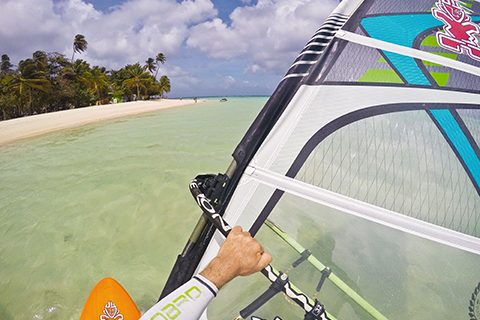
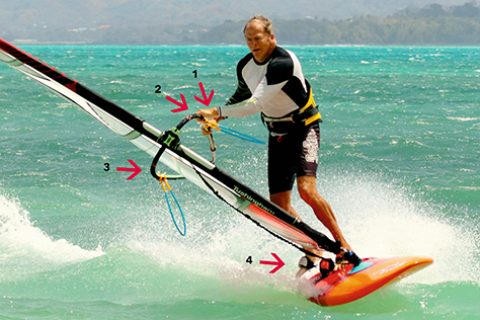
THE POWER CONTROL DIRECTORY
This shot highlights the pivotal moment just as you bear away where it’s crucial to have the rig under control, delivering the right amount of power to the right parts of the board. Power control involves many bits and body parts.
PHOTO Brett Kenny
1 Front arm
The most crucial limb as it is taking most of the power control, moving the rig forward and upright to power up – back and down to depower.
2 The back hand
Not so much pulling as holding the tension to stop the clew opening. How far back on the boom determines how hard you sheet or oversheet.
3 The rig
The leeward tilt of the rig is crucial not only to control power but also to make space for the body to move into.
4 Mastfoot
It’s like the front foot of the body – controlling the nose and engaging the front section of rail – but only if the rig is sheeted in and forward.
“ In a modern gybe, you look to use a powered rig to help you accelerate all the way round ”
First consider what happens when you bear away to gybe (assuming you’re powered up). You go from about 15 to 25 mph in the space of a second. Take away the rig and imagine how much you have to lean forward just to anticipate that acceleration and stop yourself flopping off the back. The trick is to sheet in as you bear away by extending the front arm and allow the rig to pull you forward and upright over the board to the point where you’re tripping over your feet. Until you get used to it, it’s an unsettling feeling which is why so many at this stage resist it by bending the arms and dropping back – but you have to go with that flow – and then change the direction of flow…
THE HANDLEBAR TWIST – IT’S ALL IN THE HIPS
Puff your chest out and take control of this ship. Boss the rig so it takes you where you want to go – don’t just hang on and be taken where it’s going. As you bear away, you want it to pull you forward. Then as you carve, you want it to pull you to the inside (and help you control the edge). Here comes the critical and most ignored rig move – the twist.
With a wide grip, like on a chopper motorbike handlebar (please see the film Easy Rider for reference), drop the front hand and pull the back hand as if you were turning those handlebars. That directs the rig drive towards the centre of the circle, at the same time turning your hips and pulling them over the inside edge, into a position where you can dominate and pressure the rail.
Do you not get pulled over? No, if you carve, the change of direction is so sudden that the board catches up with you. If you forget to carve, then falling is a possibility.
If you don’t twist the sail and turn the hips, you find yourself being pulled forward towards the nose with knees, hips and shoulders all pointing at the mastfoot – screaming off over a flat board, with a wild open sail on an interminable run. And why don’t people make the rig twist? Because they can’t/won’t sheet in.
SHEETING IN – MORE POWER TO YOUR NOSE
People can’t sheet in primarily because their back hand is too far forward on the boom. Like having the door knob in the middle of the door, they don’t have the leverage to pull it closed. With the hands close together the instinct is to pull on both arms, which chokes the power and makes you sit back. People won’t sheet in because the force appears to be leading them into a chasm. Nibble your way towards that chasm. Drop your back hand back perhaps half a metre, hold the tension (i.e. don’t let the boom open). Look upon your front arm as the accelerator pedal. With each gybe try extending it a little more and dropping your back hand back a little further. If you’re happily powered – not hanging on – you may begin to enjoy the sensation of being pulled into the front seat. (The front seat is where your hips are in front of your feet. The back seat is where they’re behind the feet.)
And as you drop the rig into the turn, you should begin to feel the mastfoot pressure depressing the front section of rail. The greater the twist, the more the edge bites and gouges. When you start to turn around the full rail and not just the tail, you feel yourself accelerating like a slingshot – and not just pivoting and stopping – and you’re on your way to a planing exit. The next stage is to be fully aware of the back hand position. The further back it goes, the more you automatically sheet in, the more power you direct into the rail and the tighter the arc.
This is all happening because you’re making positive use of the power and are not just hanging on.
It’s all the in hips. To carve, you have to sheet in and twist the rig, at the same time turning the hips to face the centre of the circle. That way the power pulls your weight to the inside and it’s easy to drive the edge. The 2 pics below show a classic before and after shot of Balazs at the same point in the gybe. In the first the sail is open, so hips, knees and shoulders are all facing the mastfoot from where it’s hard to pressure the rail – and he’s had to drop back to resist an open, upright rig which is heaving him downwind. In the second, he’s turned the rig and the power is taking him to the inside.
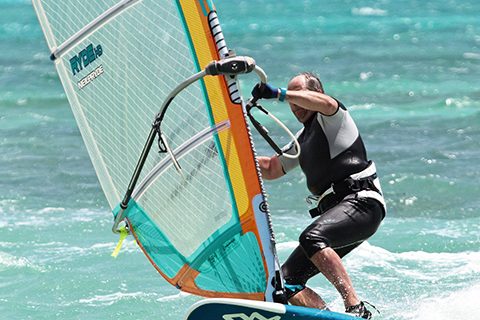 With sail open and hips and knees facing the nose, it’s hard to control the carve.
With sail open and hips and knees facing the nose, it’s hard to control the carve.PHOTO Hart Photography.
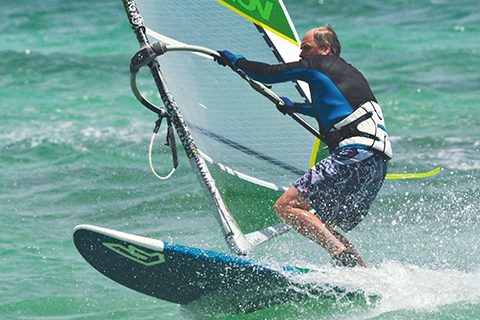
This time he’s turned the handlebars and is directing power and body to the inside. The only issue is that he likes the position so much, he’s stayed there a bit long – downwind he should already be into the transition.
PHOTO Hart Photography.
OVER-SHEETING – the how…
As you tilt off the wind to initiate in moderate conditions, even though you’re bearing away, the sudden acceleration means your apparent wind shoots forward. You then have to gather the sail to prevent being back-winded.
When it’s windier, the apparent wind doesn’t swing forward as much and that sheeting in is met with resistance – there’s too much. If you don’t get it under control you have no choice but to hold the sail open, sit back, resist and have much the same experience as a jockey being dragged behind a runaway horse. This is the bold, grunty bit. Dumping power comes from hiding the sail by dropping it to leeward, at the same time over-sheeting by pulling the clew past the optimum angle – only possible with the back hand way back.
The feeling as you drop and pull initially is that you’re going to die …. And then suddenly that you’re not. As the clew comes in and the leech opens, it all goes quiet. It’s a beautiful moment. The beast is tamed and you drop into the turn in total confidence (or so it says here …)
SHEETING IN … the when
As suggested, it is a ballsy move, hence the commonest sheeting in mistake is to delay, bear away too far and oversheet dead downwind when the rig lightens up – that’s about half an hour too late.
Depending on the wind strength the critical over-powered zone is between beam and broad reach – that’s where you need to dump power. Over-sheeting needs to happen AS you bear away. By downwind you should already be opening up into your transition. At this point it’s worth underlining the timings. Sadly it all happens much more quickly than you’d like. Bear away and sheet in for one second and on two, open out into your foot and rig change. Effectively the rig is never still, you’re either pulling in or letting out. Because that over-sheeted lay-down feeling is so wonderful, people stay there too long.
If you love it so much, start going for 360s – then you can stay there all day.
THE TRANSITION
It pains me greatly watching people do the tricky bit and then fluff the rig change – such a waste. The problem is that they’re releasing the rig because they have to, it’s about to over-power them, rather than because they want to.
If you let go of a fully powered sail which you’re resisting, there’s a wild change of pressure, which demands a huge balance readjustment on your part. There’s rarely a pretty outcome.
The two tricks to work on, which happily are the same off the plane, are:
1. Make the transition smooth – i.e. don’t let go of a fully sheeted in sail or it’ll ping round like a whip. But ease it out gradually as you turn through the wind so you’re giving to and releasing the pressure all the way round.
2. As you release it make sure you and the rig are balanced. You’ll be on your heels anticipating the pull forward as the clew swings round. And most importantly:
• the mast is tilted to windward,
• your front hand is forward on the boom by the mast (so the rig will pivot around your wrist and not swing back)
• and the rig is balancing itself. Back to the 80s and the big trick was the ‘no hands’ rig change – only possible is the rig was tilted right to the inside as you released.
The secret to seamless gybing, and the whole windsurfing universe is indeed power control and I leave you with this nugget.
When you learn to windsurf it’s all about resisting the rig. It pulls one way and you pull the other and that neutralising of forces drives the board along. And as you speed up non-planing manoeuvres it’s still about resisting – in the flare gybe for example you drop back against a windward tilted rig and get the mastfoot pressure to drive the nose round. But as you progress into planing moves, e.g. the carve gybe, another force enters the mix, the acceleration and the centrifugal one. Now you have a symbiotic relationship with the rig – sometimes you resist it but sometimes you go with its force and let it pull you. The trick is to keep moving it so it pulls you into the right positions.
Harty has a fabulous new website www.peter-hart.com revealing news of everything windsurfing including spaces on up and coming clinics. Email him for his monthly newsletter on [email protected] or like his Peter Hart Masterclass page.

